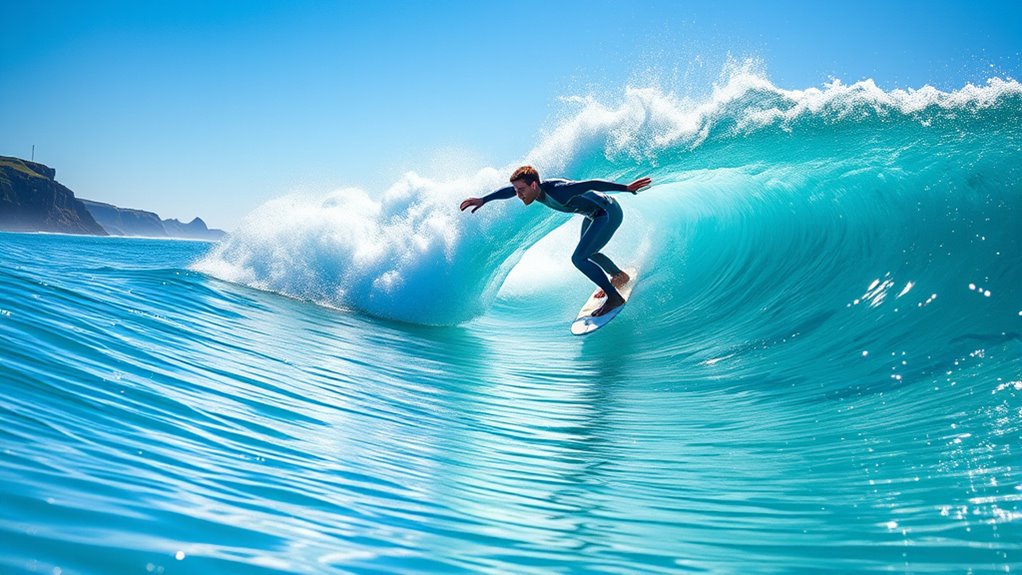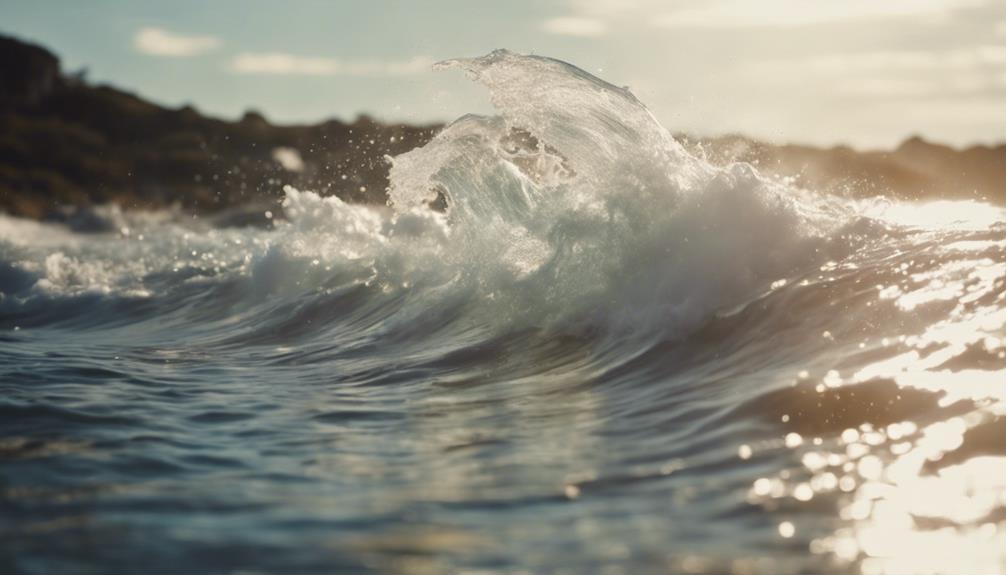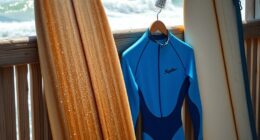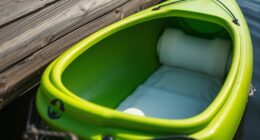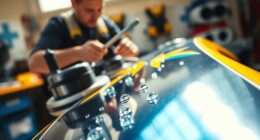To surf like a pro, focus on observing how waves form and break, noting the shape and size cues that signal a good ride. Watch for signs of dangerous hazards like rip currents and identify the best spots based on seabed features and tide shifts. Anticipate wave speed and timing by paying attention to swell direction and wind conditions. Mastering these cues helps you position yourself perfectly—keep going, and you’ll learn even more about surfing waves with confidence.
Key Takeaways
- Observe wave shape and crest formation to identify the break point and wave quality.
- Watch for shadowing and surface texture changes indicating wave speed and impending break.
- Assess underwater features like reefs and sandbars to predict wave behavior and positioning.
- Monitor tidal patterns and swell direction to anticipate wave size, power, and optimal timing.
- Recognize visual cues such as rip currents, gaps, and wave shadows for safety and better ride planning.
Understanding Wave Formation and Types

To understand how to read surfing waves, you first need to grasp how waves form and the different types you’ll encounter. Waves are created by wave energy moving through the water, influenced by wind, storms, and tides. As these waves approach shallower water in the surf zone, their energy causes them to rise and eventually break. There are several types of waves: spilling, plunging, and surging. Spilling waves gently break and are easier to ride, while plunging waves form a hollow crest perfect for advanced surfers. Surging waves don’t break cleanly and can be dangerous. Recognizing how wave energy interacts with the ocean floor helps you predict wave behavior in the surf zone, giving you a vital advantage when surfing. Understanding local wave dynamics can significantly improve your ability to anticipate wave patterns and choose the best spots to surf. Additionally, studying wave formation processes enables surfers to better interpret how different conditions influence wave behavior, which is crucial for selecting optimal surf locations. Gaining insight into these processes also aids in identifying ideal surfing conditions that maximize safety and performance. Recognizing the influence of tide levels can further refine your understanding of wave behavior and improve your surfing strategy. Being aware of modern surf forecasting technology can also help you stay ahead of changing conditions and plan your surf sessions more effectively.
Recognizing the Signs of a Breaking Wave
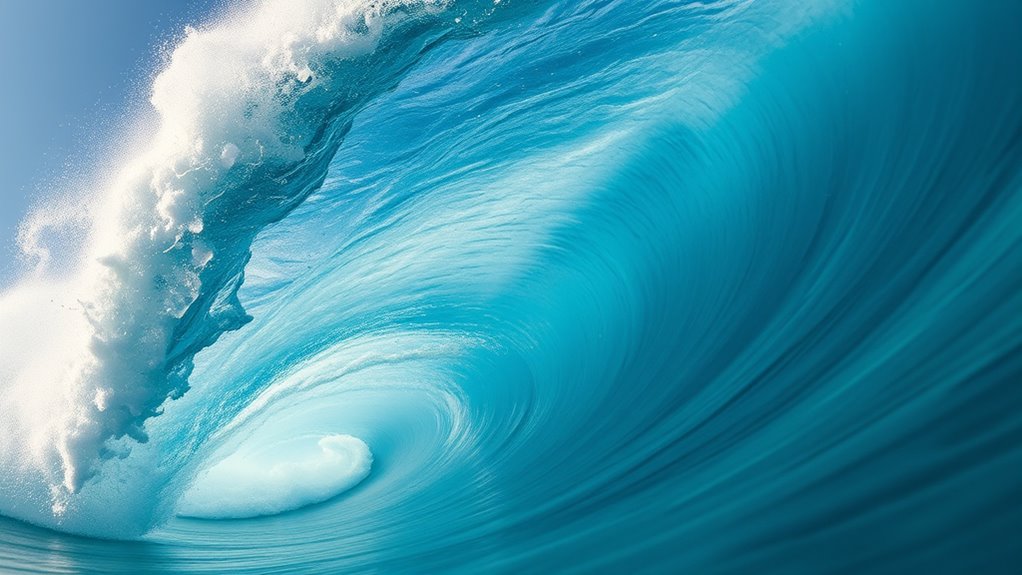
As a wave approaches, pay attention to its shape—look for a rounded crest or a steepening face that signals it’s about to break. Spotting the break line is essential; it’s the point where the wave starts to crest and spill forward. Recognizing these signs helps you anticipate when and where a wave will break, so you can time your ride perfectly. Monitoring the wave’s appearance can also indicate if the wave is fresh or has been sitting too long, which affects its break. Additionally, understanding the contrast ratio of the wave can give insights into its brightness and clarity, influencing your decision on when to catch it. Being aware of the Gold IRA market trends can also help you identify optimal times to ride the wave of investment opportunities. Recognizing the Bitcoin halving events can provide clues to potential shifts in market behavior that may impact the wave’s strength. Being able to read these signs accurately enhances your ability to predict wave behavior, ultimately improving your surfing performance.
Wave Shape Indicators
Wave shape indicators are your visual cues for spotting when a wave is about to break. Pay attention to changes in wave height; as a wave approaches its breaking point, it often grows taller and steeper. Notice the wave’s shape—an increasingly convex face signals it’s about to spill. Wave speed also increases as the wave nears breaking, causing it to accelerate toward the shore. Look for the formation of a distinct curl or ridge at the crest, which indicates the wave is about to topple. These shape clues help you anticipate the break, so you can position yourself accordingly. Recognizing these signs early gives you a pivotal advantage, letting you time your paddle and prepare for a smooth ride. Additionally, understanding wave shape indicators can improve your overall surfing technique by helping you read the ocean more effectively. Awareness of wave dynamics can also help you develop better positioning and timing, ultimately enhancing your surfing experience. Observing subtle changes in wave behavior can provide even more precise insights into when a wave will break, especially when combined with knowledge of swell patterns and local currents.
Spotting the Break Line
When you observe a wave’s shape and movement, spotting the exact point where it begins to break becomes easier. Look for key signs like wave shadowing, where the darker, shadowed area indicates the wave’s crest forming. To identify the break line, focus on these cues:
- The wave’s top starts to curl forward, signaling it’s about to break.
- You notice a sudden change in surface texture—smooth to frothy.
- The shadow shifts, revealing the wave’s shadowing pattern as it peaks.
- Other surfers’ positions and surf etiquette cues can help confirm the break point.
Recognizing these signs helps you stay safe and respectful in the water, ensuring you catch the wave at the right moment without interfering with others.
Reading the Ocean Floor and Tides

Understanding the shape of the ocean floor helps you anticipate how waves will break and where they’ll form. Pay attention to tidal movement patterns, as they influence wave size and timing. By mastering these factors, you’ll better predict surf conditions and catch more waves.
Ocean Floor Topography
Have you ever wondered how the shape of the ocean floor influences the waves you surf? Your understanding of seafloor contours and underwater features *reveal* better wave reading. Imagine these key features:
- Steep drop-offs that cause powerful, fast-breaking waves
- Shallow reefs that produce hollow, barreling waves
- Sandy bottoms that lead to softer, more forgiving surf
- Underwater ridges that redirect wave energy and shape peaks
- Recognizing these features involves understanding self watering plant pots, which utilize reservoir systems and capillary action to maintain consistent moisture levels. Additionally, understanding seafloor topography helps predict wave behavior and surf conditions more accurately. A solid grasp of wave dynamics can significantly improve your ability to anticipate wave formation and breaking patterns. Knowing how underwater features influence wave shape allows surfers to select the best spots and timing for optimal rides. Developing spatial awareness of underwater formations can also enhance your overall surfing strategy and safety.
Tidal Movement Patterns
Tides are driven by the gravitational pull of the moon and the sun, causing the ocean’s water levels to rise and fall regularly. Understanding tidal movement patterns helps you anticipate when waves will be most powerful and surfable. Use tidal predictions to plan your sessions, aligning with high or low tides for ideal conditions.
| Tidal Phase | Effect on Waves |
|---|---|
| High Tide | Waves break closer to shore |
| Low Tide | Waves are more exposed and longer |
| Rising Tide | Increasing wave energy |
| Falling Tide | Waves diminish in size |
| Slack Water | Calm period between tides |
Knowing these patterns ensures you catch the best waves and read the ocean’s rhythm like a pro.
Observing Swell Direction and Power
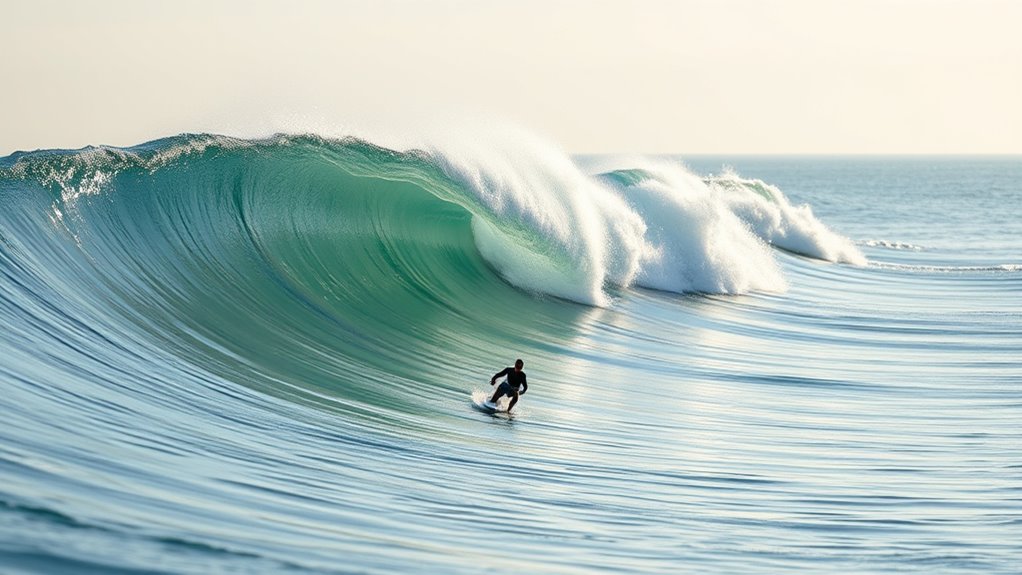
Observing swell direction and power is essential for predicting surf conditions. When you look at how the swell moves, you’ll notice its consistency and wave height variability. To gauge the swell’s strength, focus on these key points:
Monitoring swell direction and energy helps predict surf quality and consistency.
- The angle at which waves approach the shoreline, indicating the swell’s direction.
- The size and energy of the waves, revealing swell power.
- The frequency of breaking waves, showing swell consistency.
- The height fluctuations, highlighting variability in wave size.
- Monitoring the relationships between swell characteristics can also help forecast more accurate surf conditions and improve your overall understanding of wave behavior. Developing a growth mindset can enhance your ability to interpret these patterns and adapt your strategies accordingly. Additionally, understanding the swell direction helps in positioning yourself optimally for better waves. Recognizing the influence of automation in technology can further refine your ability to read and anticipate surf conditions, especially with the increasing integration of advanced tools and data analysis in surf forecasting. Being aware of wave formation processes allows surfers to better predict how swell energy interacts with local bathymetry, leading to more precise wave predictions.
Spotting Rip Currents and Hazardous Zones
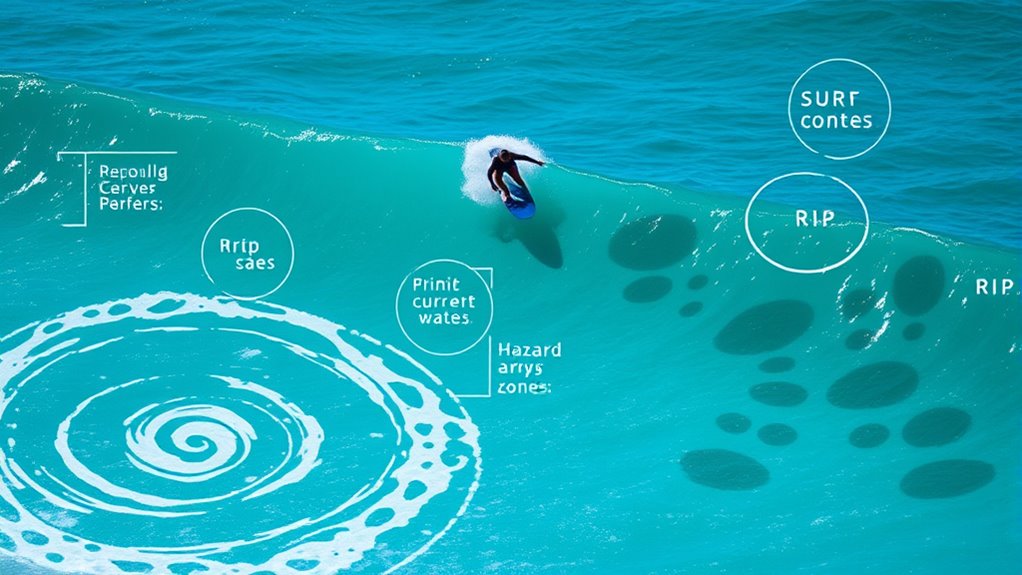
While analyzing swell patterns helps you understand wave behavior, it’s equally important to recognize areas where rip currents and other hazards may form. Hazardous zones often appear as calmer patches amidst breaking waves, signaling rip currents pulling water away from the shore. Look for channels of churning, discolored water that move swiftly offshore; these are classic signs of rip currents. Additionally, watch for gaps in the surf line, where waves don’t break consistently, indicating possible hazardous zones. Sharp, sudden changes in wave height or direction can also point to dangerous spots. Identifying rip currents early helps you stay safe and avoid getting caught in a strong pull. Always stay alert, especially near piers, jetties, or sandbars, where hazards are more prevalent.
Timing and Positioning for the Perfect Ride

Timing and positioning are crucial to catching the best waves and riding them smoothly. To do this, you need to read the wave height and adjust your position accordingly. First, identify where the wave is about to break. Second, paddle with purpose to be in the right spot before the wave reaches you. Third, choose your surfboard based on wave height; smaller boards work better for faster, steeper waves, while larger ones help in slower, mushier surf. Fourth, commit to your timing—paddle early and smoothly to catch the wave at the peak. Proper positioning means being slightly ahead of the breaking crest, so you’re in the ideal spot to ride. Mastering this balance ensures a smooth, powerful ride every time.
Interpreting Wind Conditions and Their Effects

Understanding how wind affects surf conditions is key to making the most of your ride. Wind patterns influence wave quality, size, and shape, so paying attention to them gives you a strategic advantage. Offshore winds, for example, help clean up the wave face, making it smoother and more rideable. On the other hand, onshore winds tend to produce choppy, less predictable surf. To stay ahead, check gust forecasts regularly; strong gusts can quickly change wave conditions, impacting your timing. Light, steady winds usually create ideal conditions, while sudden gusts can cause inconsistent surf. By interpreting wind patterns and monitoring gust forecasts, you can better anticipate how the waves will behave, giving you a higher chance of catching those perfect rides.
Practicing Visual Cues for Better Wave Prediction

Practicing visual cues is essential for predicting wave behavior more accurately. To sharpen your skills, focus on key signs like:
- Watching for wave shadowing, which reveals the wave’s direction and speed.
- Noticing how the crest forms and breaks, indicating the wave’s strength.
- Observing the ripple patterns on the water surface to anticipate upcoming waves.
- Paying attention to other surfers’ positions and respecting surf etiquette, which helps you understand wave flow and priority.
Frequently Asked Questions
How Can I Improve My Wave Reading Skills Quickly?
To improve your wave reading skills quickly, focus on wave timing and surf zone identification. Pay close attention to how waves form and when they break, which helps you anticipate their movement. Practice observing the surf zone early on, noticing where waves start to rise and break. By consistently analyzing these cues, you’ll develop better instincts for catching the best waves, boosting your confidence and performance in the water.
What Equipment Helps in Better Wave Prediction?
Think of your equipment as a weather forecast for your surfing journey. Using advanced surf charts helps you see upcoming wave patterns, much like a weather map predicts storms. Devices like wave forecasting apps and buoy data give you real-time insights, allowing you to anticipate swell sizes and timings. This gear sharpens your wave prediction skills, making you more confident and prepared to catch the best waves.
Are There Specific Signs of Dangerous Waves I Should Watch?
When spotting dangerous waves, keep an eye on wave height; larger waves can be more hazardous. Watch for rip currents, which appear as discolored, choppy water flowing away from the shore—these can quickly pull you out. Also, be cautious of sudden, steep, or rapidly breaking waves, as they signal increased danger. Recognizing these signs helps you stay safe and make informed decisions before riding.
How Do Different Surf Spots Affect Wave Behavior?
Imagine each surf spot as a unique story waiting to unfold. Different spots affect wave behavior through tide influence and reef formations, shaping how waves break and their size. You’ll notice that at reef breaks, waves are often more powerful and well-shaped, while tide changes can dramatically alter wave height and surfability. Understanding these factors helps you anticipate wave patterns and surf safely and confidently, no matter where you ride.
Can Weather Patterns Change Wave Formations Suddenly?
Weather variability can definitely cause sudden changes in wave formations, so you should stay alert. Shifts in wind, storms, or pressure systems can alter wave size and shape quickly. While forecast accuracy has improved, it’s still wise to check updated weather reports before heading out. By understanding how weather patterns influence waves, you’ll better anticipate changing conditions and improve your ability to read waves like a pro.
Conclusion
By mastering these skills, you’ll read waves like a pro and catch the best rides. Pay close attention to the ocean’s signs, and don’t rush your decision—patience pays off. Remember, “every wave has its rider,” so stay alert and trust your instincts. With practice and observation, you’ll improve your timing and confidence, making each surf session more enjoyable and safe. Keep learning, and the ocean will always be your guide.

